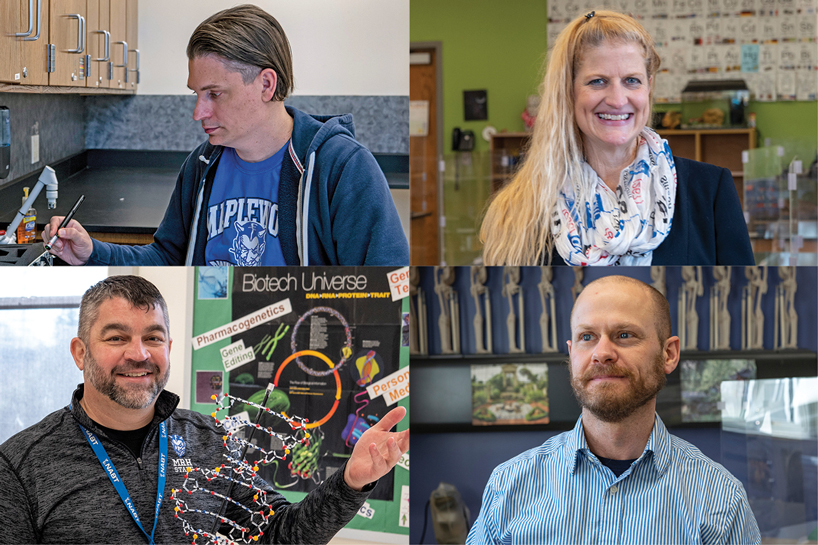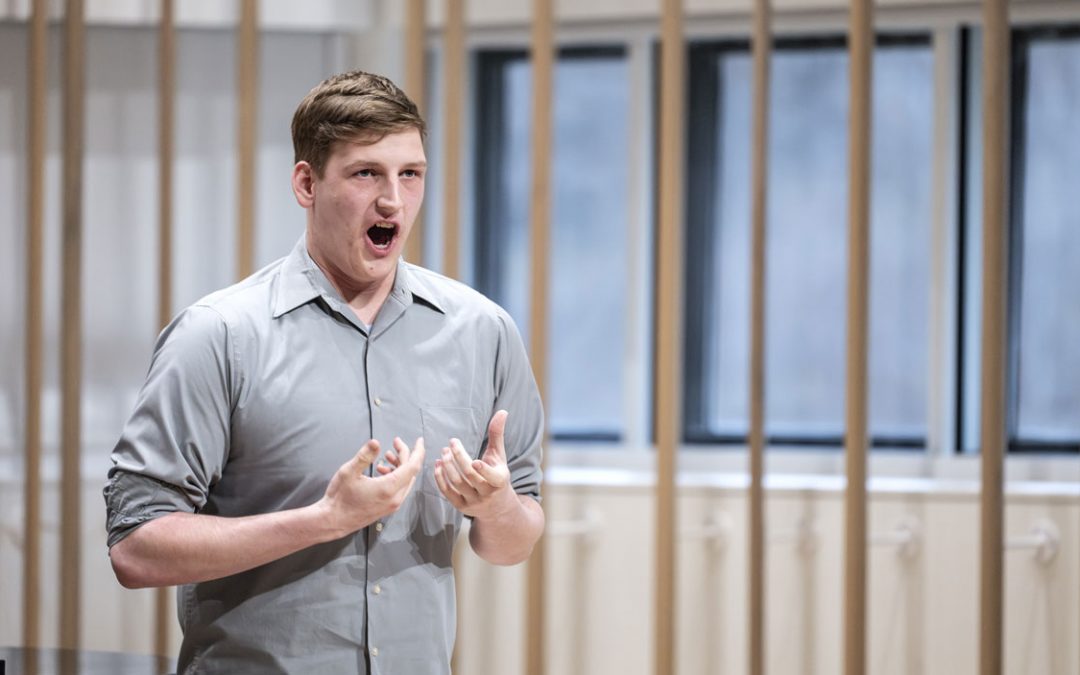
Together, Ben Nims, the natural and environmental sciences teacher at Maplewood Richmond Heights High School, and his colleagues chemistry teacher Kathleen Dwyer, physics teacher Ryan Massey and biology teacher Chuck McWilliams all hold doctorates. They comprise the only multi-faculty science department in the state in which each member has a terminal degree. (Photos by August Jennewein)
When the science staff of Maplewood Richmond Heights High School meets, the salutations tend to be rather tongue-in-cheek nowadays.
“When we’re all together in the same space, which isn’t that often now, we can say, ‘Doctor, doctor, doctor, doctor,’” Ben Nims says with a laugh.
It’s a joke but not an exaggeration.
Nims, the natural and environmental sciences teacher at MRH, and his colleagues chemistry teacher Kathleen Dwyer, physics teacher Ryan Massey and biology teacher Chuck McWilliams all hold doctorates.
Together, they comprise the only multi-faculty science department in the state in which each member has a terminal degree.
The road to this unique situation runs directly through the University of Missouri–St. Louis, where they all earned their doctorates – Dwyer, McWilliams and Nims doing so in the same EdD program.
Though there’s far more that joins them, including the friendship and mentorship of Charles Granger and a shared drive to continually pursue knowledge.
“I think all four of us are lifelong learners, and we like to go to school,” McWilliams says.
Granger, Curators’ Distinguished Teaching Professor of biology and education at UMSL, is a tireless advocate for science education in the region. Over the years, he has directed 18 science education programs, and the MRH science staff has directly benefitted from several of them.
Around 2008, Massey entered the Cooperative Approach to Doctoral Research in Education program, a partnership between UMSL and Washington University in St. Louis’ Center for Inquiry in Science Teaching and Learning funded by the National Science Foundation and coordinated by Granger.
The program provides a collaborative environment for educators to pursue EdD or PhD coursework, while enhancing science literacy and expertise.
“I got lucky to be accepted into the program, which provided a lot of funding and allowed me to take coursework much quicker,” Massey says. “I was able to take a lot of grad school classes and be part of a group, a support network of science teachers.”
Massey completed the bulk of his PhD work in the program but finished his degree a few years later at UMSL with Keith Miller, Orthwein Endowed Professor for Lifelong Learning in the Sciences. For his dissertation, Massey investigated the applications of computer science and coding in teaching physics.
Dwyer, McWilliams and Nims began the STEM THEMES cohort in 2017, one of the College of Education’s innovative EdD programs, which emphasizes collaboration and is designed to be completed in three years.
McWilliams and Nims were encouraged to apply after participating in the Missouri Science Teacher Education Partnership, yet another program Granger shepherded with E. Desmond Lee Professor in Zoological Studies Patricia Parker, former Executive Director of the Whitney R. Harris World Ecology Center Patrick Osborne and former Associate Professor of Teaching and Learning Joe Polman.
With the two of them on board, Dwyer quickly followed suit.
“It was the design of the program itself that was attractive to me,” Dwyer says. “The fact that it was a cohort. If Ben and Chuck had not also been on it, I don’t know If I would have registered. I was really intrigued by the opportunity to work with them on this level.”
The cohort made it possible for them to conduct research and write a dissertation together. It took some time to land on the final topic, but McWilliams notes they were all in agreement to study something that would inform their everyday instruction.
“We were interested in motivation and what gets students interested in wanting to do science, not just succeeding in science classes – but wanting to be a scientist,” Nims says. “We moved from that to a parallel track, to this idea of identity and the social research behind identity. What are those things that help formulate a science identity in students?”
After interviewing former students pursuing undergraduate degrees in STEM fields, common themes emerged.
It’s clear that “authentic research experiences” are incredibly important to cultivating a science identity. Students who conducted their own research or worked in a lab in high school and early in college were challenged but also developed a sense of belonging in the field.
Students who didn’t have those experiences felt like they had to achieve more and more – another class, another research paper, a degree – to actually consider themselves scientists.
“The other emerging pattern was really about relationships,” McWilliams says. “The students that went into STEM majors had some adult in their life – it was either a parent or a teacher – who they saw as a support system. Someone who could really guide them and motivate them in that pursuit of their interests.”
They successfully defended their dissertation last year and are examining how they can leverage what they learned to benefit MRH High School and the school district at large. At minimum, it furthers their case to preserve the elective research science class at MRH.
“We have evidence for the impact that it’s had on our students,” Dwyer says. “It’s a really important class to preserve, not just for the students who take it and learn through the research project. They present to other students, and the other students get a sense of what real science is, how it’s conducted, and that pulls them in. It is rare for high schools to offer science research as a class, but it is really critical.”
As their dissertation showed, those early research opportunities are often the key to building the confidence to enter STEM fields. MRH students are uniquely positioned to benefit from a class dedicated to those opportunities and educators who have conducted research at the highest level.
Not only are their students receiving high- caliber instruction, they’re also seeing the day- to-day work that goes into being a scientist in the research elective and core science classes. Few other high school students in the region experience such expertise on a daily basis or the encouraging environment it fosters.
“It’s really about blurring the lines between what’s a teacher and what’s a researcher,” Massey says. “It’s more powerful when you have both of those tools.”
The science staff hopes to eventually apply their work more broadly, but the COVID-19 pandemic has put things on hold at the moment.
McWilliams says they’ve been preoccupied with redesigning their lessons for remote and hybrid instruction. However, he adds that they would like to condense some of their research into a workshop for other teachers in the district to underscore the importance of building science identities through supportive teacher-student relationships and hands-on experiences.
The collaborative aspects of their research programs also reinforced the value of intra-department communication. McWilliams says it made him aware that being on the same page – even teaching different classes – can positively impact students.
“The students that we get in our school, they see all of us,” he says. “At the end of four years at this school, what is their story? What is their experience going to be?”
With four doctors on staff, it’s safe to assume the kids will be alright.
It’s an unusual reality, but it’s perfectly in line with their collective ambition to explore new topics and unanswered questions. While it’s novel now, perhaps it will be less so in the future.
“I hope other departments are given opportunities like Chuck Granger was able to give us,” Massey says. “It made such an impact for us. I’d love to see it happen at other schools.
This story was originally published in the spring 2021 issue of UMSL Magazine. If you have a story idea for UMSL Magazine, email magazine@umsl.edu.














